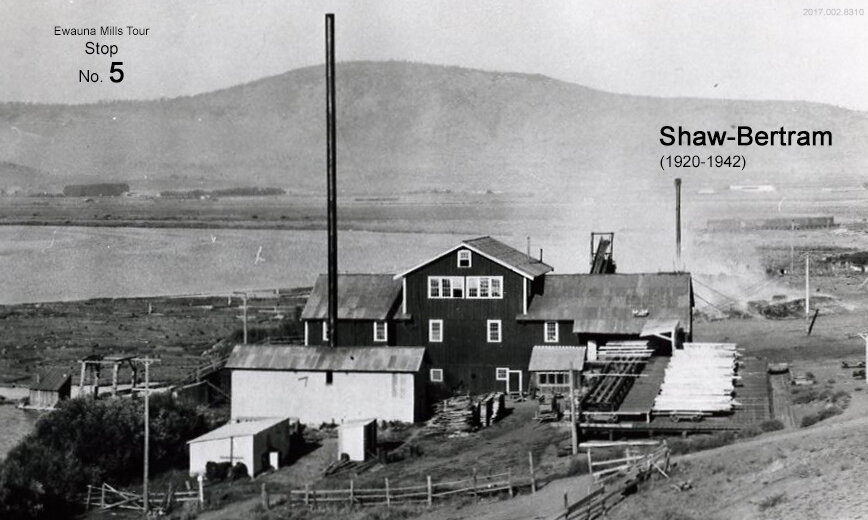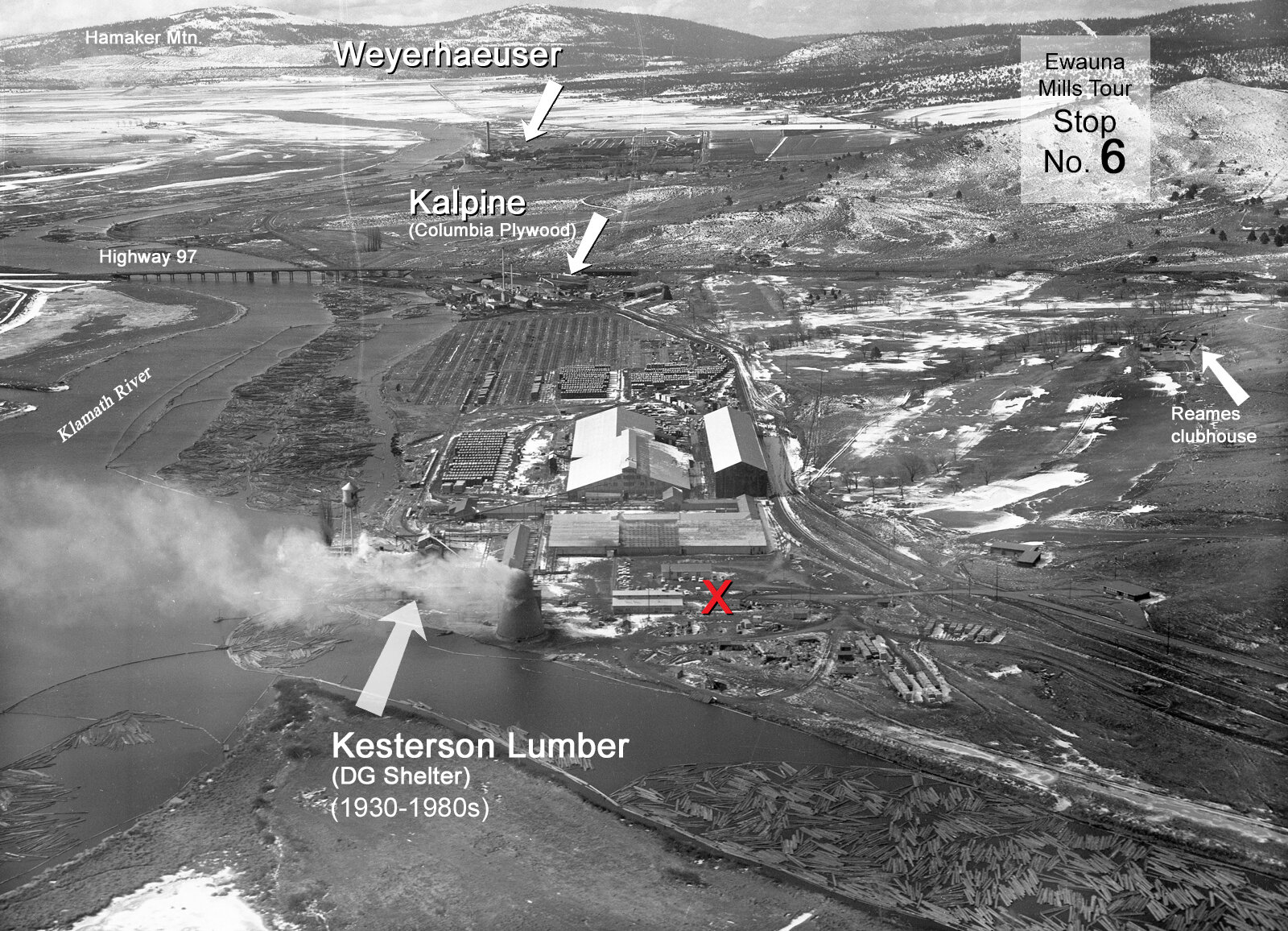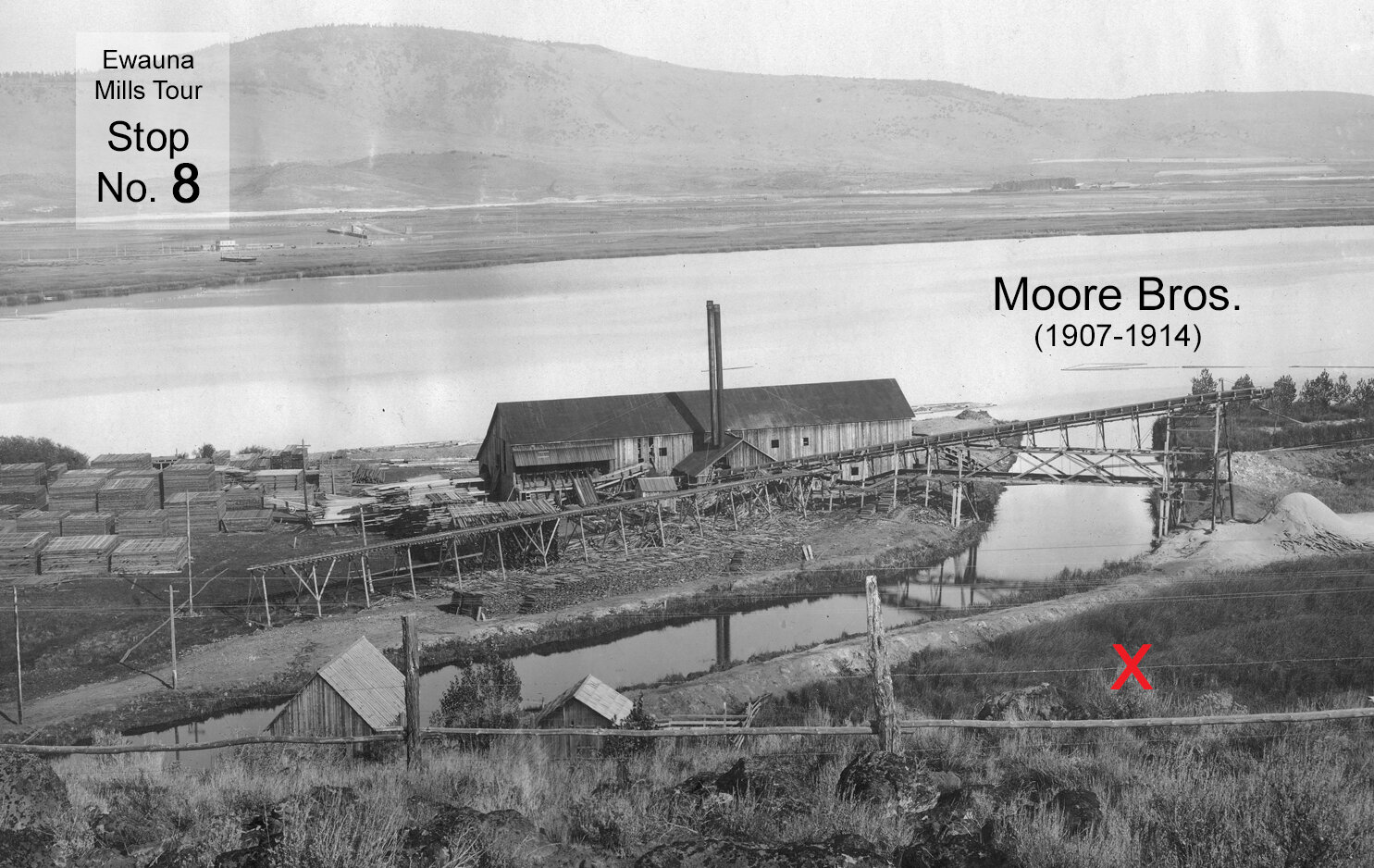Lumber Mills Around Lake Ewauna
Photos to accompany Mills Around Lake Ewauna Tour on Aug. 15, 2020.
Click here to see tour route on Google Maps.
Click on image to advance to next slide.
Lumber Mills on Lake Ewauna
Notes by Ron Loveness
Aug. 15, 2020
Lake Ewauna served as the mill pond for nine different sawmills over the years. Untold millions of board feet of logs were hauled to the lake, mostly by rail, from the early 1900s on.
Lake Ewauna is classified as a navigable waterway by the State of Oregon. In order to have booming rights (to store logs), a mill had to own some shoreline to have the right to place pilings used to anchor rafts of logs. Modoc Lumber ended up being “the last man standing” along Lake Ewauna having acquired all other former mill properties and as a result owns all of the shoreline upstream of the RR bridge. This property now managed by Timbermill Shores is one of the largest pieces of vacant waterfront property in the West that has total infrastructure available; highway, rail, water, sewer, fire hydrants, electricity and natural gas.
Ackley Brothers
In 1894 Al Fitch built the first sawmill in Klamath County to have a stationary boiler and steam engine. It was the fastest mill in southern Oregon up to that date and was capable of cutting up to 20,000 bd ft/ day. The mill ran for nine years until Fitch lost his life when crushed by a log. In 1904 John and Henry Ackley purchased the machinery and moved it to the shore of Lake Ewauna near where Veteran’s Park is now located. In 1920 the circular saws were replaced with a band saw and the sawing capacity increased to 50,000 bd. ft. per day. In the 1940s the mill was leased and later purchased by the Shaw family, eventually becoming Modoc Lumber, and operating until 1968. Modoc built a new sawmill on the former Big Lakes Box / Eldorado/ Ellingson Lumber mill site.
Ewauna Box
In 1912 C.B. Crisler and Charles McGowan organized the Ewauna Box Company and built a box factory on S 6th St. A few years later McGowan sold his interests to Claude Daggett and Fred Shallock. In 1917 the factory burned and was immediately replaced with the largest and most modern box factory on the west coast and the 2nd largest in the nation. In 1920 the company added a single band sawmill, then a planning mill and drykilns. In 1926 the sawmill was expanded to a 3 bandsaw mill. The Ewauna mill broke production records with a cut of 95 million bd, ft, in 1928. In the 1940s Weyerhaeuser purchased the Ewauna plant and along with its timberlands in Lake County. Weyco closed and dismantled the plant and hired the entire crew to add a third shift to their operations.
During the depression, Klamath Basin mills did better than most other areas as about half of their output was for box lumber - mostly produce boxes and crates. Klamath Falls was closest to the California market for fruit and vegetable packing. Families came to Klamath Falls for work as box factories were very labor intensive. For example, a train carload of empty lettuce crates consisted of 15,000 boxes. Each lettuce crate consisted of 30 slats, lugs and end pieces. This meant that a carload of empty lettuce crates contained about a half a million individual pieces of wood. It was common for a long term box factory worker to be missing fingers. Another controversy was that the women of the family got preference for hiring as they were paid less than men.
Big Lakes
In 1917 the Big Lakes Box Company was organized by A,J Voye, M.S. West and Burge Mason. The company purchased the lumber yard property of Savidge Brothers Sawmill on S 6th St, and changed it over to a box factory. In 1920 a single band sawmill was built on Lake Ewauna and in 1927 a resaw was added. The plant included dry kilns and planning mill. In the 1950s Loren Palmerton’s Eldorado Lumber purchased the plant and sold it to Ellingson Lumber in 1954. The plant was closed then burned in the early 1960s. The plant site was acquired by Modoc Lumber where a new sawmill was built in 1968.
Chelsea / Shaw-Bertram
In 1917 Curt Setzer organized the Chelsea Box Company which built a factory on the East shore of Lake Ewauna near the stock yards and railroad. In 1920 the plant was sold to Growers Packers and Warehousing Association. It burned in 1924 and the property sold.}
In 1920 J.R. Shaw and W.J. Bertram built a single bandsaw mill on the former Chelsea Box property. In 1925 a box factory was added. Shaw bought out Bertram and it became Shaw Lumber Company. Dry kilns and a planing mill were added later. The access road to the Chelsea factory and Shaw-Bertram plant was so bad that the crew was taken to work via boat during bad weather. The plant was sold to the Southern Pacific Company in 1934 after the Shaw Lumber Company built a new sawmill and box factory at Tionesta, CA on the Great Northern RR in Modoc County. The Southern Pacific leased the mill to Long-Bell Lumber and sold it to the lesee in 1939. In 1942 Weyerhaeuser Timber Company purchased the property along with the Long-Bell tract of timber in northern Klamath County. The mill was dismantled except for the water tower...The water tower is still in use by the oil recycling plant located West of Tingley Lane and North of the South Side Expressway.
Kesterson / DG Shelter
In 1930 the Kesterson Lumber Company formerly of Dorris, CA built a sawmill on Klamath River 2 miles South of Klamath Falls. The plant consisted of a bandsaw headrig, and a resaw; in conjunction were a battery of dry kilns, planing mill and box factory. The mill’s machine shop and planning mill buildings still stand, as does the water tower. DG Shelter moved their operations there from Upper Klamath Lake in 1963. The mill closed around 1984.
Kalpine
In 1938 the Kalpine Plywood Company built a plant between Weyerhaeusr and Kesterson on the Klamath River. This later became Klamath Plywood, and is now Columbia Forest Products.
Weyerhaeuser
After purchasing a great deal of timber in Klamath and adjacent counties over a long period of years, the Weyerhaeuser Timber Company in 1929 built a large modern plant on the Klamath River 4 miles south of Klamath Falls. The sawing equipment consisted of four double cutting bandsaw headrigs, and a gang saw. In connection with the mill were huge lumber sheds, planning mill, a large battery of dry kilns and a box factory. It was the largest pine cutting sawmill in the world, replacing the 3 headrig Red River sawmill in Westwood (Lassen County), CA. Plywood, particle board and hardboard plants were subsequently added. The log processing facilities were closed in the 1990s and Collins Products acquired the hardboard plant.
Great Northern
The railroad drawbridge across Lake Ewauna was built in 1928, when the Great Northern Railroad arrived in town. Its passenger and freight terminals were located on South Sixth, but its roundhouse was on the west side of Lake Ewauna.
The last time the drawbridge was thought to have been last raised in the late 1950s or early 1960s for a raft of white fir logs from Weyerhaeuser to Modoc Lumber while at the fomer Ackley mill site. Another possibility was to let a pile driver through in order to replace pilings to anchor log rafts.
Moore Brothers
William Moore moved to the Klamath Agency in 1868 from the Willamette Valley and constructed a sawmill for the Government in 1870. In 1877 he constructed a water powered sawmill on Link River about halfway between Lake Ewauna and Upper Klamath lake. A canal was built from the lake to the mill to provide water for power and also float logs to the mill. A 10 to 12 man crew could produce eight to ten thousand bd. ft.of lbr / day. William promptly sold the mill to his two sons Charles and Rufus Moore who added a planer and operated the mill for 30 years until 1907.
The Moore Brothers then built a fast steam-driven circular mill with a capacity of 50,000 bd ft/ day on the west shore of Lake Ewauna near the mouth of Link River on a site built by the Adams Dredge. At first logs were harvested west of Wampler Creek, then rafted and towed down the lake and finally driven down Link River. Driving logs down Link River proved entirely unsatisfactory. Thereafter, logs were obtained from the Keno district and towed up the river. In 1910 the mill was sold to Ines and Clark and operated for 2 years and then sold to the Big Basin Lumber Co, a subsidiary of the Klamath Development Co. The mill operated another 2 years.
In 1915 the Klamath Manufacturing Co purchased the machinery from Big Basin and built a mill adjacent to their box factory at Shippington. A band mill was added before the plant was later sold to the Earl Fruit Company and operated as Klamath Lumber and Box. The plant was later purchased by the DiGorgio Fruit Corp and closed when DiGorgio moved their operations to the former Kesterson mill on Klamath River, operating under the name DG Shelter.
The Westside Bypass (Highway 97) was constructed from the north side of town to Main Street in 1959. A bridge across Link River was completed in 1963. The bypass was extended from the downtown exit, over the site of the Moore mill, to the Greensprings Highway in 1968.









